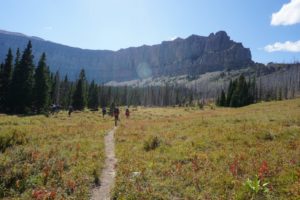
On a gusty day in Half Moon Basin, a meadow surrounded by towering mountains where we were camping, I participated in my favorite school assignment of all time. Every student had the opportunity to pick a plant to observe, sketch, read about in a nature guide, and make a creative piece about it. I had been looking forward to this assignment ever since I got my course syllabus.
After getting the instructions, we scattered to find our own plants. On the side of the large meadow, there were a few pine trees under which I found a cluster of yellow wildflowers that resembled snapdragons. I sat next to them, examining their details, tasting, and drawing them. The practice was meditative. Zeroing in on a single plant and watching it sway in the breeze, sitting in the sunshine… I could have been there for hours.
After lunch, the whole group walked around to look at the plants that each person chose. I had expected to learn about the different plants in the area, but I was surprised to find out that I ended up learning just as much about the people who observed the plants as the plants themselves. Each person’s choice and their methods of observation reflected their personalities.
Some people (like me) chose wildflowers, looking for whimsical beauty. One student who has an eclectic aesthetic and loves art sketched the bright, wacky-looking sticky purple geranium leaves she chose with a face on them. Another student picked a spiky thistle that he poked at, and nearby, one fully uprooted his plant, the arrowleaf balsamroot. During the activity, I found myself thinking as much about my fellow classmates as the plants.
In this course, we studied the main values of Western science, including objectivity. One of the core beliefs is that anyone should be able to re-create an experiment and achieve the same results. The observers—the scientists conducting experiments—don’t matter, only the subjects of it do. However, Robin Wall Kimmerer says that in traditional ecological knowledge practices, when you study a plant, you build a relationship with it. What you take away from an interaction is not dependent on just the plant itself, but you as well. Just like a relationship between two individual people, the relationship is unique to you and the plant.
If I had picked one of the plants that my classmates chose, I certainly would have taken away different ideas. I never would have thought to take out my pocket-knife, dig a giant hole, and pull out the plant to look at the roots. The scientist, their experiences and personality, might have a larger impact on an experiment than Western science would believe. Looking at the same common toadflax flower I chose, also known as “butter-and-eggs,” each one of us would see it a little bit differently.
Anna Feldman is a student at the University of Wisconsin-Madison studying biology and journalism. This past summer, she worked as a camp counselor at a French camp in the San Juan Islands in Washington. During the year, she enjoys biking around and going to cafes in Madison.